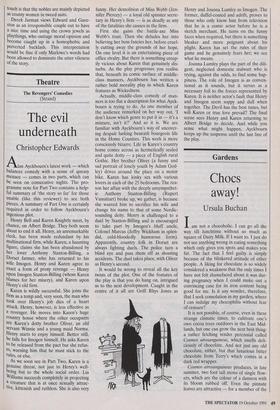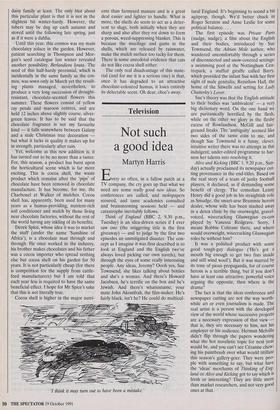Gardens
Chocs away!
Ursula Buchan
It is not possible, of course, even in these strange climatic times, to cultivate one's own cocoa trees outdoors in the East Mid- lands, but one can grow the next best thing: a rather fetching tender perennial called Cosmos atrosanguineus, which smells deli- ciously of chocolate. And not just any old chocolate, either, but that luxurious bitter chocolate from Terry's which comes in a dark red wrapper.
Cosmos atrosanguineus produces, in late summer, two foot tall stems of single flow- ers, which are the colour of a damson with its bloom rubbed off. Even the pinnate leaves are attractive — for a member of the
daisy family at least. The only blot about this particular plant is that it is not in the slightest bit winter-hardy. However, the tubers may be dug up each autumn and stored until the following late spring, just as if it were a dahlia.
Until this year, this cosmos was my main chocolatey solace in the garden. However, patient searching in Thompson and Mor- gan's seed catalogue last winter revealed another possibility, Berlandiera lyrata. The seed of this half-hardy perennial, which is incidentally in the same family as the cos- mos, was sown only in March yet the result- ing plants managed, nevertheless, to produce a very long succession of drought- resistant, chocolate-scented flowers this summer. These flowers consist of yellow ray petals and maroon centres, and are held 12 inches above slightly coarse, silver- green leaves. It has to be said that the chocolate fragrance is not my favourite kind — it falls somewhere between Galaxy and a stale Christmas tree decoration — but what it lacks in quality it makes up for in strength, particularly after rain.
Yet, welcome as this new addition is, it has turned out to be no more than a taster. For, this season, a product has burst upon the horticultural scene which is far more exciting. This is cocoa shell, the waste product which remains after the 'pips' of chocolate have been removed in chocolate manufacture. It has become, for me, the Charbonel et Walker of mulches. Cocoa shell has, apparently, been used for many years as a humus-providing, nutrient-rich soil conditioner and mulch by those living near chocolate factories, without the rest of the world having any inkling of its benefits.
Derek Spice, whose idea it was to market the stuff (under the name 'Sunshine of Africa'), is a chocolate man through and through. He once worked in the industry, his brother makes chocolates and his father was a cocoa importer who spread nothing else but cocoa shell on his garden for 50 years. It is not particularly cheap (for there is competition for the supply from cattle- feed manufacturers) but I am told that each year less is required to have the same beneficial effect. I hope for Mr Spice's sake that this is not literally true.
Cocoa shell is higher in the major nutri- 'I think it may turn out to have been a mistake.' ents than farmyard manure and is a great deal easier and lighter to handle. What is more, the shells do seem to act as a deter- rent to slugs, both initially when they are sharp and also after they rot down to form a porous, weed-suppressing blanket. This is because the mucilage and gums in the shells, which are released by rainwater, make the mulch surface too tacky for them. There is some anecdotal evidence that cats do not like cocoa shell either.
The only real disadvantage of this mate- rial (and for me it is a serious one) is that, once it has degraded to an attractive chocolate-coloured humus, it loses entirely its delectable scent. Oh dear, choc's away.



























































 Previous page
Previous page